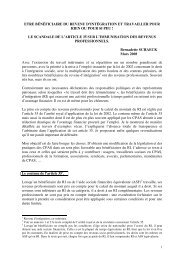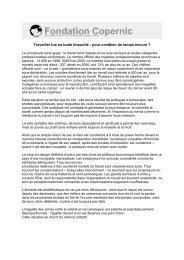Awra Amba RJ 300612 EN - Contacter un comité local d'Attac
Awra Amba RJ 300612 EN - Contacter un comité local d'Attac
Awra Amba RJ 300612 EN - Contacter un comité local d'Attac
You also want an ePaper? Increase the reach of your titles
YUMPU automatically turns print PDFs into web optimized ePapers that Google loves.
Women <br />
(%) <br />
Adults <br />
Men (%) <br />
Women / <br />
men <br />
Children <br />
(%) <br />
Sample (person number) 80 80 80 <br />
4. Social organisation<br />
Children <br />
/ <br />
adults <br />
Land cleaning 99 100 0.99 21 0.21 <br />
Ploughing 15 100 0.15 0 0 <br />
Sowing 99 98 1.01 0 0 <br />
Weeding 99 100 0.99 9 0.09 <br />
Harvesting 94 99 0.95 11 0.12 <br />
Transporting the harvest 94 99 0.95 0 0 <br />
Threshing 51 98 0.53 6 0.08 <br />
Storing 94 98 0.96 4 0.04 <br />
Non weighted average 80 99 0.82 6 0.07 <br />
Table 6:<br />
Participation rate in % to different agricultural activities according to sex and age acc.<br />
to data by Atnafu (2005/77). Colours show the most inegalitarian cases.<br />
These results are apparently answers to a questionnaire and not co<strong>un</strong>ts of the tasks done really by<br />
men and women. A limited co<strong>un</strong>t we have done in 2010 (Jo10b/4) showed that:<br />
- For the traditionally female tasks, out of 51 people carrying water from the spring (and<br />
therefore carrying about fifteen kilograms), 35 were still women (2.2 times more than men),<br />
that out of ten spinners in the cooperative, eight were women (4 times more than men), and<br />
out of fourteen spinners during the development day on the village square, twelve were<br />
women (6 times more than men);<br />
- For the traditionally male trades, out of eleven weavers in the cooperative, eight were men<br />
(2.7 times more than women), and the five ploughmen we saw were all men.<br />
These figures measured on very small samples and therefore few representative show a greater<br />
difference in the tasks per sex than the difference measured by declarative survey by Atnafu.<br />
Furthermore, 4 % of the male heads of house hold have no access to media (radios, newspapers), but<br />
14 % of the female ones according to Ya08/93: we could have here a slight inequality between the<br />
sexes, but this conclusion must be put into perspective because of the small sample and the non<br />
taking into acco<strong>un</strong>t of other possibly explanatory factors.<br />
Gender equality in the various tasks seems therefore not fully reached, but we also have to consider<br />
that the tasks are also attributed according to capacity: spinning is an easy task, ploughing is<br />
physically very difficult, some tasks more dangerous for women. In comparison with the allocation<br />
of the tasks according to the sex in the Amhara society, a large part of the objectives seems to be<br />
reached, which is considerable.<br />
We can therefore say there is equality in couple as producers, as consumers, as responsible of tasks<br />
and works and as responsible of the family, although Mekonnen (2009/45) considers it is without<br />
doubt exaggerated.<br />
Symbolically, as long as the father lives, he is considered as the head of the family. This is due<br />
partially to the automatic acknowledgement by the neighbours and related people external to <strong>Awra</strong><br />
<strong>Amba</strong> of the father as the head of the house hold (At05/39-40). But the head of the house hold does<br />
not play really the role of a head... Father's name is the middle or parent name of children (Yi07/60).<br />
51 / 85

















